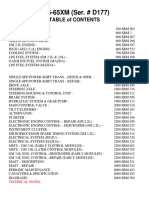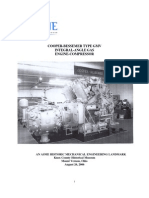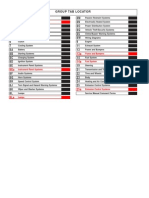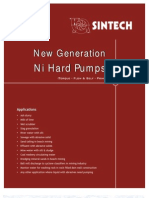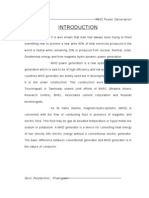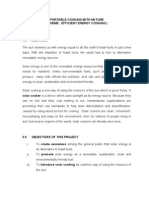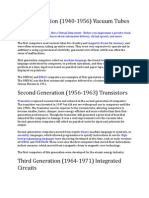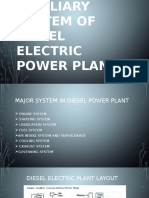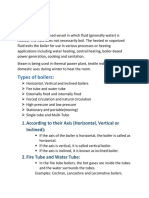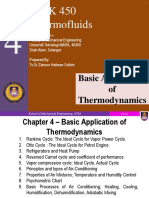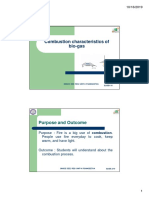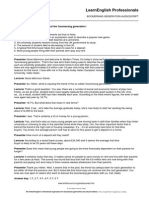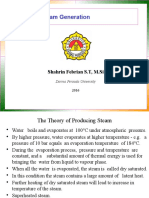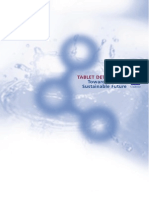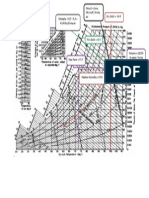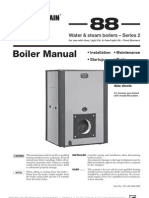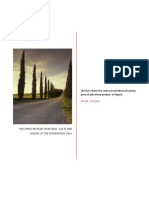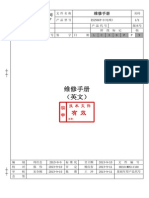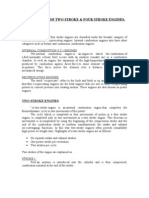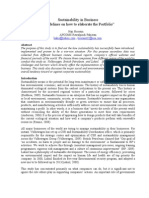Steam Generation PDF
Steam Generation PDF
Uploaded by
Khairatun NisaCopyright:
Available Formats
Steam Generation PDF
Steam Generation PDF
Uploaded by
Khairatun NisaOriginal Title
Copyright
Available Formats
Share this document
Did you find this document useful?
Is this content inappropriate?
Copyright:
Available Formats
Steam Generation PDF
Steam Generation PDF
Uploaded by
Khairatun NisaCopyright:
Available Formats
Theory of Steam Generation
Progressive Development of Power Generation through
Steam Generation
The Theory of Producing Steam
Water boils and evaporates at 100C under atmospheric pressure.
By higher pressure, water evaporates at higher temperature - e.g. a
pressure of 10 bar equals an evaporation temperature of 184C.
During the evaporation process, pressure and temperature are
constant, and a substantial amount of thermal energy is used for
bringing the water from liquid to vapour phase.
When all the water is evaporated, the steam is called dry saturated.
In this condition the steam contains a large amount of latent heat.
Further heating of dry saturated steam will lead to increase in
temperature of the steam.
Superheated steam.
Steam generator versus steam boiler
Opposite the principle of the steam boilers, the water in the
steam generators evaporates inside the tube winded up into
serial connected tube coils.
The feed water is heated up to the evaporation temperature and
then evaporated.
The intensity of the heat, the feed water flow and the
size/length of the tube are adapted, so that the water is exactly
fully evaporated at the exit of the tube.
This ensures a very small water and steam volume (content of
the pressure vessel).
Thus there are no buffer in a steam generator, and is it
temporary overloaded.
The advantages using a steam generator compare to
conventional steam boilers.
Easy to operate - normally no requirement for boiler
authorisation
Rapid start-up and establishing full steam pressure
Compact and easy to adapt in the existing machinery
arrangement
Price attractive - especially at low steam rates.
The advantages using a steam generator compare to
conventional steam boilers:
Easy to operate - normally no requirement for boiler
authorisation
Rapid start-up and establishing full steam pressure
Compact and easy to adapt in the existing machinery
arrangement
Price attractive - especially at low steam rates.
Progress in Rankine Cycle Power Generation
Year
1907 1919
1938 1950
1958 1959
1966
1973
1975
MW
20
30
60
120
200
500
660
1300
p,MPa
1.3
1.4
4.1
6.2
10.3
16.2
15.9
15.9
24.1
Th oC
260
316
454
482
538
566
566
565
538
Tr oC
--
--
--
--
538
538
566
565
538
FHW
--
5.1
4.5
3.4
3.7
3.7
4.4
5.4
5.1
~17
27.6
30.5
35.6
37.5
39.8
39.5
40
Pc,kPa 13.5
h,%
--
Steam Generation Theory
Within the boiler, fuel and air are
force into the furnace by the
burner.
There, it burns to produce heat.
From there, the heat (flue gases)
travel throughout the boiler.
The water absorbs the heat, and
eventually absorb enough to
change into a gaseous state steam.
To the left is the basic theoretical
design of a modern boiler.
Boiler makers have developed
various designs to squeeze the
most energy out of fuel and to
maximized its transfer to the
water.
Water enters the boiler, preheated, at the top.
The hot water naturally circulates through the tubes down to the lower
area where it is hot.
The water heats up and flows back to the steam drum where the steam
collects.
Not all the water gets turn to steam, so the process starts again.
Water keeps on circulating until it becomes steam.
Meanwhile, the control system is taking the temperature of the steam
drum, along with numerous other readings, to determine if it should
keep the burner burning, or shut it down.
As well, sensors control the amount of water entering the boiler, this
water is know as feedwater.
Feedwater is not your regular drinking water.
It is treated with chemicals to neutralize various minerals in the water,
which untreated, would cling to the tubes clogging or worst, rusting
them.
This would make the boiler expensive to operate because it would not
be very efficient.
On the fire side of the boiler, carbon deposit resulting from improper
combustion or impurities in the fuel can accumulate on the outer
surface of the water tube.
This creates an insulation which quickly decrease the energy transfer
from the heat to the water.
To remedy this problem the engineer will carry out soot blowing. At a
specified time the engineer uses a long tool and insert it into the fire
side of the boiler.
This device, which looks like a lance, has a tip at the end which "blows"
steam.
This blowing action of the steam "scrubs" the outside of the water
tubes, cleaning the carbon build up.
Water tube boilers can have pressures from 7 bar to as high as 250
bar.
The steam temperature's can vary between saturated steam, 100
degrees Celsius steam with particle of water, or be as high as 600 650 degrees Celsius, know as superheated steam or dry steam
The performance of boiler is generally referred to as tons of steam
produced in one hour.
In water tube boilers that could be as low as 1.5 t/hr to as high as
2500 t/hr.
You might also like
- Hyster H D177Document892 pagesHyster H D177Eriflona88% (8)
- Cooper Bessemer BrochureDocument12 pagesCooper Bessemer Brochurepemex87100% (2)
- 2000 Jeep Wrangler Service Manual TJDocument1,407 pages2000 Jeep Wrangler Service Manual TJfluencyband100% (5)
- Literature Review: 2.1 - Internal Combustion EnginesDocument28 pagesLiterature Review: 2.1 - Internal Combustion EnginesMustafa AppNo ratings yet
- LAB Report 01 Meen 20110104Document13 pagesLAB Report 01 Meen 20110104Zohaib Arif MehmoodNo ratings yet
- Classification of Heat EnginesDocument20 pagesClassification of Heat EnginesParva ShrivastavaNo ratings yet
- Distributed Generation in Developing CountriesDocument12 pagesDistributed Generation in Developing CountriesZara.FNo ratings yet
- Steam & Power Generation Lab (ME-218-F)Document27 pagesSteam & Power Generation Lab (ME-218-F)Abdalla ElemamNo ratings yet
- Electricity GenerationDocument68 pagesElectricity GenerationAdeniji Olusegun100% (1)
- Thermo Power GenerationDocument177 pagesThermo Power GenerationAmpornchai PhupolNo ratings yet
- Boiler PerformanceDocument31 pagesBoiler PerformanceIrfan ShaikhNo ratings yet
- Power Generation ThroughDocument22 pagesPower Generation ThroughHari650No ratings yet
- Sollutions To Water PollutionDocument9 pagesSollutions To Water Pollutionslychn100% (1)
- Co GenerationDocument14 pagesCo GenerationDairo Ruiz-LogreiraNo ratings yet
- Chapter 2 - Analysis of Steam Power Plant CycleDocument61 pagesChapter 2 - Analysis of Steam Power Plant Cyclerrhoshack100% (1)
- 4.1 BoilerDocument40 pages4.1 BoilermechgokulNo ratings yet
- New Generation Ni Hard PumpsDocument6 pagesNew Generation Ni Hard PumpsGaurav NarulaNo ratings yet
- Gas Power Cycles Sivakumar.E VITDocument47 pagesGas Power Cycles Sivakumar.E VITmohan govindasamyNo ratings yet
- Steam Power PlantsDocument65 pagesSteam Power PlantsVictoria CantiladoNo ratings yet
- 9what Is A Boiler?Document59 pages9what Is A Boiler?Ali MuradNo ratings yet
- How Are Supercritical Boilers Different From Subcritical BoilersDocument2 pagesHow Are Supercritical Boilers Different From Subcritical BoilerssbmmlaNo ratings yet
- WASTE HEAT RECOVERY (HRSG) PerformanceDocument17 pagesWASTE HEAT RECOVERY (HRSG) PerformanceEjaz AhmedNo ratings yet
- Mechanical Engg.: Report On Industrial TrainingDocument44 pagesMechanical Engg.: Report On Industrial TrainingSakshi SanghiNo ratings yet
- Lecture Note - Steam CycleDocument37 pagesLecture Note - Steam CycleSuchi Suchi SuchiNo ratings yet
- Solar Thermal Power PlantDocument32 pagesSolar Thermal Power Plantvigneshgemini100% (1)
- Steam-Generating PDFDocument84 pagesSteam-Generating PDFRenz Ryan Dolor100% (1)
- Boiler PerformanceDocument20 pagesBoiler Performancesameer betalNo ratings yet
- MHD-power GenerationDocument15 pagesMHD-power GenerationDIPAK VINAYAK SHIRBHATE80% (5)
- A PPT Presentation On Compressed Air EngineDocument17 pagesA PPT Presentation On Compressed Air EngineAnonymous 1MSe8zNo ratings yet
- New Generation of Cisco SwitchingDocument50 pagesNew Generation of Cisco SwitchingSalis AlvarezNo ratings yet
- Steam Power PlantDocument7 pagesSteam Power PlantNav Mehra50% (2)
- 8 Vapor and Combined Power CyclesDocument14 pages8 Vapor and Combined Power CyclesAbdur Rashid100% (1)
- Cooking With Nature 2011Document8 pagesCooking With Nature 2011Linda MuhamadNo ratings yet
- First GenerationDocument2 pagesFirst GenerationAlan RoxasNo ratings yet
- Internal Combustion EngineDocument35 pagesInternal Combustion EngineMuhammad FaizNo ratings yet
- Chapter CogenerationDocument6 pagesChapter Cogenerationpratosh1313No ratings yet
- Vapor Power CyclesDocument55 pagesVapor Power CyclesTarikuNo ratings yet
- Chapter 1Document24 pagesChapter 1ahmed jemalNo ratings yet
- Auxiliary System of Diesel Electric Power PlantDocument12 pagesAuxiliary System of Diesel Electric Power PlantAllen EspeletaNo ratings yet
- Types of BoilersDocument9 pagesTypes of BoilersAhmad CheemaNo ratings yet
- New Generation in Pre-Heating TechnologyDocument16 pagesNew Generation in Pre-Heating TechnologymetudgnNo ratings yet
- Assignment - 2 (Waste Heat Recovery)Document4 pagesAssignment - 2 (Waste Heat Recovery)Akmal Hafeez Muhammad HafeezNo ratings yet
- MEK450-Chapter - 4 - Basic Application of ThermodynamicsDocument98 pagesMEK450-Chapter - 4 - Basic Application of ThermodynamicsMUHAMMAD MIKAEL MOHD FAIRUSNo ratings yet
- Steam Turbine PowerpointDocument25 pagesSteam Turbine PowerpointD.P. MishraNo ratings yet
- Basic of Gas TurbinesDocument48 pagesBasic of Gas Turbinessrexpower100% (2)
- Combustion Characteristics of Bio-Gas: Purpose and OutcomeDocument5 pagesCombustion Characteristics of Bio-Gas: Purpose and OutcomeNandakumar100% (1)
- Waste Heat RecoveryDocument37 pagesWaste Heat Recoveryommech2020No ratings yet
- Lecture 3 - Improving Performance - RegenerationDocument5 pagesLecture 3 - Improving Performance - RegenerationMuhammad Alam Zaib KhanNo ratings yet
- General Layout of The Plant: Power PlantsDocument15 pagesGeneral Layout of The Plant: Power Plantsamitandy134No ratings yet
- Course Solar Taylor ThermalDocument68 pagesCourse Solar Taylor ThermalFatah BouhiredNo ratings yet
- Lab Report 12Document8 pagesLab Report 12mamoona noreenNo ratings yet
- IVT Heat PumpsDocument12 pagesIVT Heat Pumpskushik9781No ratings yet
- Doc-2 Training Material On Coal Fired Thermal Power PlantsDocument21 pagesDoc-2 Training Material On Coal Fired Thermal Power PlantsSharan100% (2)
- General Layout of Modern Steam Power PlantDocument15 pagesGeneral Layout of Modern Steam Power Planttabishkhanalig100% (1)
- 05EEE - 2023 - Variable Load On Power SystemDocument31 pages05EEE - 2023 - Variable Load On Power SystemAmbadiNo ratings yet
- 01 History of Refrigeration PDFDocument34 pages01 History of Refrigeration PDFNSS GBPECNo ratings yet
- Gas Turbine Power PlantDocument20 pagesGas Turbine Power Plantumar100% (1)
- Lec 3 BoilerDocument20 pagesLec 3 BoilerRajiv SharmaNo ratings yet
- Parabolic Dish ConcentratorDocument1 pageParabolic Dish ConcentratorArjunSinghNo ratings yet
- Boomerang GenerationDocument1 pageBoomerang GenerationVu Manh CuongNo ratings yet
- Theory of Steam GenerationDocument8 pagesTheory of Steam Generationraudatul22No ratings yet
- Progressive Development of Power Generation Through Steam GenerationDocument8 pagesProgressive Development of Power Generation Through Steam GenerationAshish GauravNo ratings yet
- Mechanics of the Household: A Course of Study Devoted to Domestic Machinery and Household Mechanical AppliancesFrom EverandMechanics of the Household: A Course of Study Devoted to Domestic Machinery and Household Mechanical AppliancesNo ratings yet
- Bahan KimiaDocument4 pagesBahan KimiaKhairatun NisaNo ratings yet
- APLIKASI SS 2015 Fix PDFDocument3 pagesAPLIKASI SS 2015 Fix PDFKhairatun NisaNo ratings yet
- Need A Scholarship: Want A Good SupportDocument1 pageNeed A Scholarship: Want A Good SupportKhairatun NisaNo ratings yet
- Bahan KimiaDocument4 pagesBahan KimiaKhairatun NisaNo ratings yet
- Tablet Detergent UnileverDocument6 pagesTablet Detergent UnileverKhairatun NisaNo ratings yet
- Basic RefineryDocument17 pagesBasic RefineryKhairatun NisaNo ratings yet
- Refrigeration CyclesDocument17 pagesRefrigeration CyclesKhairatun NisaNo ratings yet
- Processflowdiagrampg 130810211631 Phpapp01Document14 pagesProcessflowdiagrampg 130810211631 Phpapp01Khairatun NisaNo ratings yet
- Khairatun Nisa - Humidity ChartDocument1 pageKhairatun Nisa - Humidity ChartKhairatun NisaNo ratings yet
- SAlient Features of CAADocument12 pagesSAlient Features of CAAJaypee EvangelistaNo ratings yet
- 3tnv82a Bdsa2Document2 pages3tnv82a Bdsa2Baggerking0% (1)
- GeneratorDocument22 pagesGeneratorbanan maintechNo ratings yet
- International: Dry CargoDocument8 pagesInternational: Dry CargoGustavo PalaciosNo ratings yet
- SM - Small - MK - IV - Rev - 0 - Nov - 06Document672 pagesSM - Small - MK - IV - Rev - 0 - Nov - 06SMM ENTREPRISE100% (1)
- Pipe Terms PDFDocument109 pagesPipe Terms PDFLourdes Marie Rosalejos OrtegaNo ratings yet
- WM 88 Series2 IOMDocument40 pagesWM 88 Series2 IOMMike JacobsonNo ratings yet
- Coal Explosions in Cement IndustryDocument17 pagesCoal Explosions in Cement Industrymareymorsy2822No ratings yet
- Fundamentals of Oil RefineryDocument12 pagesFundamentals of Oil Refineryvenkatrangan2003No ratings yet
- Mitsubishi Project Report PDFDocument44 pagesMitsubishi Project Report PDFsameer kumar100% (1)
- Curriculum Vitae: Mohammad KamranDocument3 pagesCurriculum Vitae: Mohammad KamranVirendra GuptaNo ratings yet
- Course Drill 39hr Bucyrus System Hydraulic Lubrication Air Mechanical Training PDFDocument179 pagesCourse Drill 39hr Bucyrus System Hydraulic Lubrication Air Mechanical Training PDFBruno Cecatto100% (1)
- Experimental Investigation of Intake Diesel Aerosol Fuel Homogeneous Charge Compression Ignition (HCCI) Engine Combustion and EmissionsDocument15 pagesExperimental Investigation of Intake Diesel Aerosol Fuel Homogeneous Charge Compression Ignition (HCCI) Engine Combustion and EmissionsarulrajasiNo ratings yet
- PSI HD Technical Standard 56300004x - 8.1L Turbo Engine Ratings and Specifications Rev CDocument3 pagesPSI HD Technical Standard 56300004x - 8.1L Turbo Engine Ratings and Specifications Rev CfreyespadaaNo ratings yet
- 1.2 KW Green Turbine BrochureDocument10 pages1.2 KW Green Turbine BrochureUmar MajeedNo ratings yet
- Fuel Price IncreaseDocument5 pagesFuel Price Increaseozoemena29No ratings yet
- Zongshen RX3 Owners ManualDocument80 pagesZongshen RX3 Owners Manualjimm50% (4)
- P11301EN Euro 6 Engines Ready For The MarketDocument9 pagesP11301EN Euro 6 Engines Ready For The MarketCalvin Tan YS0% (1)
- Case 580b Industrial Tractor Operators ManualDocument8 pagesCase 580b Industrial Tractor Operators Manualrichardleclerc1974No ratings yet
- Dodge Nitro KA - 2007 - Auto Trans Nag1 Torque Converter PDFDocument14 pagesDodge Nitro KA - 2007 - Auto Trans Nag1 Torque Converter PDFeephantomNo ratings yet
- Craftsman 3.7 Cu - in 24 Inch Guide Bar Chain SawDocument30 pagesCraftsman 3.7 Cu - in 24 Inch Guide Bar Chain Sawsnowman1579100% (1)
- Komatsu 930E-5SE Electric Drive Truck Spec SheetDocument4 pagesKomatsu 930E-5SE Electric Drive Truck Spec Sheetelectronico007No ratings yet
- A Comparison of Two Stroke & Four Stroke EnginesDocument4 pagesA Comparison of Two Stroke & Four Stroke EnginesLubna KhanNo ratings yet
- Study, Analysis and Design of Automobile Radiator PDFDocument10 pagesStudy, Analysis and Design of Automobile Radiator PDFRamón G. PachecoNo ratings yet
- Motor Q's & A'sDocument282 pagesMotor Q's & A'sBalraj Singh SandhuNo ratings yet
- Sustainability in BusinessDocument11 pagesSustainability in Businesshakisi6054No ratings yet
- Air Pollution ExperimentDocument7 pagesAir Pollution ExperimentHema LataNo ratings yet
